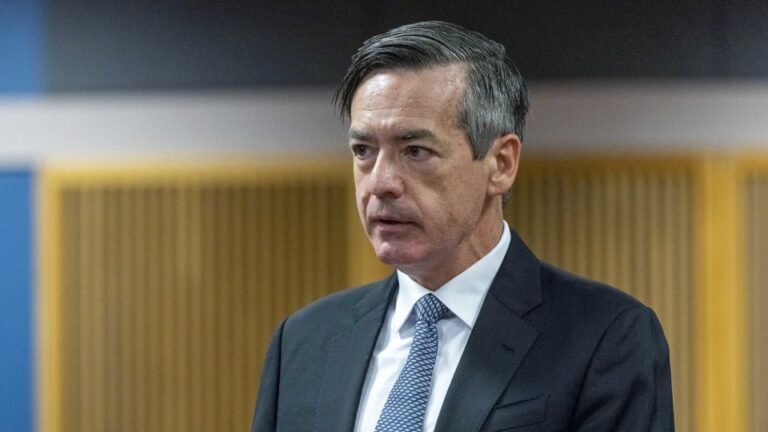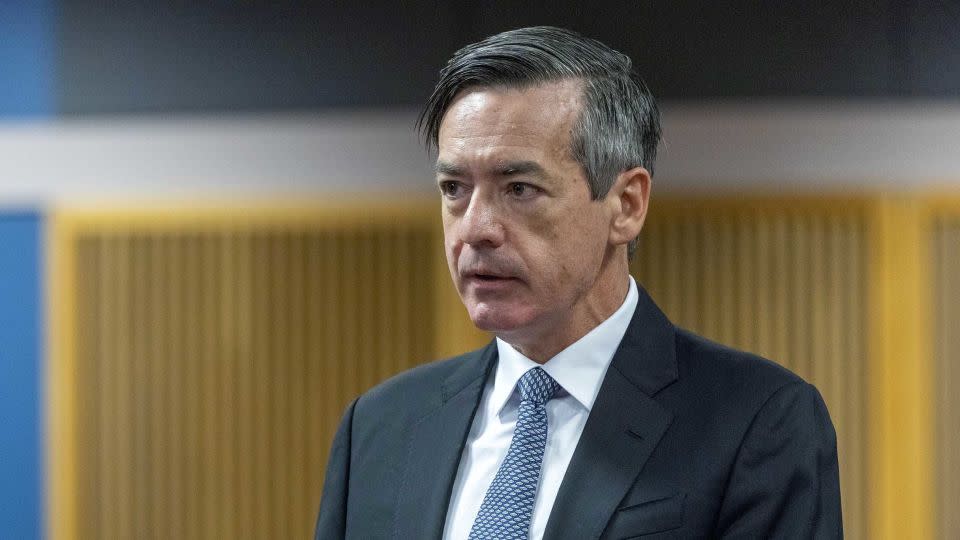
[ad_1]
Before a group of supportive lawyers entered the Oval Office for a photo-op with then-President Donald Trump in December 2020, they were given a clear instruction, according to one attendee: Don’t get Trump’s hopes up about overturning the election.
One attorney, Jim Troupis, toed the line. He’d just finished leading Trump’s failed election challenge in Wisconsin, and bluntly told the president it was over in that state.
But when the conversation shifted to Arizona, attorney Kenneth Chesebro deviated from the plan. He told Trump he could still win – and explained how the “alternate electors” he helped assemble in Arizona and six other states gave Trump an opening to continue contesting the election until Congress certified the results on January 6, 2021.
Chesebro’s optimistic comments immediately created problems by apparently giving Trump renewed hope that he could still somehow stay in office. Former RNC chairman Reince Priebus left the meeting “extremely concerned” about the January 6 conversation. Priebus, a Wisconsin native who served as Trump’s first chief of staff, later warned Troupis and Chesebro not to tell anyone about what happened.
This dramatic account comes from Chesebro, who sat for an interview last week with Michigan state prosecutors investigating the fake electors plot. CNN has exclusively obtained audio of that interview, which includes previously unreported details about the pivotal Oval Office meeting.
The Michigan attorney general already charged the 16 Republican electors who cast sham ballots in Lansing, and CNN recently reported that the investigation is still ongoing. Fifteen of the electors pleaded not guilty; one got his charges dropped in a cooperation deal.
The “photo-op … gone south,” as Chesebro called the December 16, 2020, meeting, reveals a previously unknown instance of Trump hearing directly that he lost – which could factor into his federal election subversion trial. But it also highlights how others in Trump’s orbit leaned into his delusions and aided his quixotic effort to cling onto power.
As often happened, Trump heard what he wanted to, ignoring Troupis and embracing Chesebro’s theories. Trump continued to falsely claim victory in Wisconsin and elsewhere, including on January 6, when he tried to weaponize the illegitimate GOP electors to “disenfranchise millions of voters,” according to his federal indictment.
CNN has previously identified Chesebro as an unindicted co-conspirator in Trump’s federal case. His cooperation in Michigan and other states could boost special counsel Jack Smith’s prosecution, even though it’s currently unclear if Chesebro intends to directly cooperate with Smith.
Giving Trump false hope
On December 14, 2020, the Wisconsin Supreme Court rejected Trump’s lawsuit to nullify the state’s election results. Days later, Troupis and other GOP lawyers involved in the case flew to Washington, DC, to participate in a Senate hearing about election issues, and also secured a conciliatory Oval Office photo-op with Trump.
“There was a conscious effort to deflect him from a sense of any possibility that he could pull out the election,” Chesebro told Michigan prosecutors about the thinking going into the meet-and-greet with Trump. “…Our marching orders were: Don’t say anything that makes him feel more positive than the beginning of the meeting.’”
It’s unclear who gave the so-called “marching orders” to the group of pro-Trump attorneys.
Nonetheless, Chesebro told Trump he could still prevail in Arizona. He also spelled out the basics of the fake electors scheme, where Trump supporters in seven critical states cast faux ballots and signed phony certificates claiming they were the rightful electors.
“I ended up explaining that Arizona was still hypothetically possible — because the alternate electors had voted,” Chesebro told Michigan state investigators, later adding that this made it “clear (to Trump) in a way that maybe it hadn’t been before, that we had until January 6 to win.”
“And that, you know, created a real problem,” Chesebro added.
A source told CNN that a visibly angry Priebus, who arranged the photo-op for his home-state delegation, intervened to shut down the conversation after he saw Chesebro whispering to Trump about election procedures.
“It was a photo-op and Trump talked to a lot of people. I don’t think the event lasted very long,” a lawyer for Chesebro told CNN when asked about the whispering.

The fallout was swift. Right after the meeting, Priebus was “extremely concerned” about Chesebro’s comments about January 6, according to Chesebro, who told Michigan investigators that Priebus “was going to do damage control … to mitigate whatever optimism I guess I created.”
Two days later, Chesebro got a stern email from Troupis. The message, which was obtained by CNN, said: “Reince was very explicit in his admonition that nothing about our meeting with the President can be shared with anyone. The political cross-currents are deep and fast and neither you or I have any ability to swim through them.”
Some details of the meeting were previously reported by The Washington Post.
Michigan probe casts wide net
CNN previously reported that Chesebro was cooperating with state investigators in Michigan, Nevada, Wisconsin and Georgia, where he was indicted alongside Trump and 17 others, and pleaded guilty in October to participating in the electors conspiracy. (Trump pleaded not guilty.) Chesebro hasn’t been charged anywhere else, and he hopes his state-level cooperation will keep it that way.
Over several hours of interviews last week, Chesebro provided Michigan investigators with extraordinary details of how a legal memo he wrote for Troupis in Wisconsin transformed into a nationwide operation to overturn the results of a presidential election, according to the audio obtained by CNN.
CNN reported last week that the probe is still active. It is being led by Michigan Attorney General Dana Nessel, a Democrat, who has faced sharp criticism from Republicans for what they believe is a partisan attempt to criminalize legally protected political activity.
According to the audio, members of Nessel’s team peppered Chesebro with questions about senior Trump campaign operatives, and zeroed in on how they directed the fake electors in Michigan.
Investigators asked about former Trump lawyer Rudy Giuliani, his ally and former NYPD commissioner Bernie Kerik, Trump campaign official Mike Roman, current Trump lawyer Boris Epshteyn, Trump 2020 campaign lawyers Matt Morgan and Justin Clark, and others.
Chesebro said “it was very fluid,” but all of these players were involved.
Michigan investigators asked Chesebro detailed questions, including: Who designed the fake certificates that the GOP electors signed? Who was responsible for recruiting the Michigan participants? How did the signed certificates get from Lansing to D.C.?
He pointed investigators to Giuliani, who “was pushing the idea of alternate electors very strongly,” and said Kerik “handled a lot” of the organizational activity in Michigan. Roman was “really effective at carrying out operational matters,” Chesebro said, so he was picked to be the point-person to help with the “whipping” operation on a state-by-state basis.
Kerik and Clark did not comment for this story. A representative for Epshteyn couldn’t be reached for comment. Giuliani, Roman and Morgan didn’t respond to CNN’s inquiries.
Giuliani and Roman were indicted in Georgia in connection with the electors plot. They pleaded not guilty. Giuliani is also an unindicted co-conspirator in Trump’s federal case.
‘Zero hope’ in Wisconsin
In Trump’s federal case, prosecutors highlighted the pattern of Trump allies repeatedly telling him that he lost the election. This forms the basis of Smith’s allegation that Trump “widely disseminated his false claims of election fraud for months, despite the fact that he knew, and in many cases had been informed directly, that they were not true.”
The new revelations from Chesebro’s sit-down with Michigan investigators add to the list. He said Troupis, a former judge, told Trump to his face that there was nothing left he could do in Wisconsin, where the state’s Supreme Court narrowly rejected his case.
“It’s clear that Troupis personally, told the President there was zero hope for Wisconsin,” Chesebro recalled to the Michigan prosecutors. “Part of this message, I think, (was) crafted to try to get him to concede or just you know, give up this long shot challenge.”
He said, “this was an effort to massage information going to the client in a way that was not fully candid.” He believed Troupis overstated the finality of the Wisconsin challenge.
Troupis did not respond to CNN’s request for comment.
Despite being told there was no way to undo Joe Biden’s victory in Wisconsin, Trump pressured then-Vice President Mike Pence to reject the state’s Democratic electors on January 6, while he presided over the congressional certification of the 2020 results.
At Trump’s infamous speech on January 6, he told the crowd that “we won Wisconsin” and falsely claimed Democrats facilitated 91,000 “unlawful votes” via dropboxes and 170,000 “illegal” votes through mail-in ballots. Many of these same allegations were raised – and dismissed – in the lawsuit Troupis took to the Wisconsin Supreme Court.
CNN’s Zachary Cohen contributed to this report.
For more CNN news and newsletters create an account at CNN.com
[ad_2]